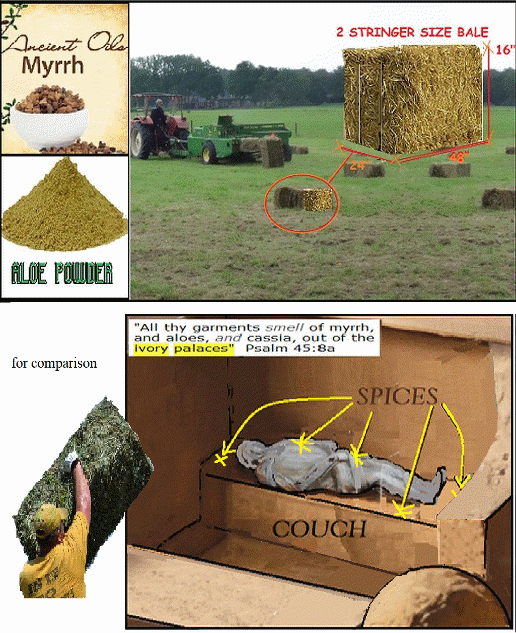
My correspondent asked me, "What happened to the spices?" Which spices? The women's spices? "No; what happened to the spices that were buried with Jesus?" The quantity causes one to wonder how they were applied. After the resurrection were they still in the tomb? Note: Correspondent comment on the hay bale analogy at end.
WHATEVER HAPPENED TO
THE BURIAL SPICES?
Incidental question: What do the spices have to do with a bale of hay?
HISTORICAL DEATH OF JESUS. Historiansi witness that Jesus was killed by the Romans. The apostle Johnii bore record that he saw a soldier's lance pierce Jesus' side and that blood and water came forth. Scientists attest that this indicates He was either dead by what is called hypovolemic shock or by asphyxiation, either of which can result in fluid gathering around the heart.iii Hence, the water and blood tells us that Jesus was dead.
But what happened to His dead body? What about the spices? Is there any significance in considering the spices?
ABANDONED? The apostles and close disciples of Jesus have been criticized for "scattering"iv and lacking sensitivity to the death of their Master. This appears to me to be an unfair assessment. Peter with only one sword was ready to die with the Lord before the soldiers could take him away. Jesus stopped him.v This action by Jesus would have produced confusion among the others whose intent had been to also die with the Lord but obviously were forbidden. Lacking substitute leadership, they would naturally disperse and being frightened, appear to have abandoned the Lord and the Kingdom of God. Even the boastful Peter denied knowing Jesus when accosted during the trials.vi
But the burial spices tell a story of devotion to Jesus: two quiet men and a group of Galilee women who visibly had not abandoned the Lord. Yet their sympathy in no way indicates any collusion of deception by promoting a Jesus resurrection. Indeed, it would support just the opposite.
TWO "BRAVE" MEN. Critics of the disciples designate both Joseph and Nicodemus as "strangers" who took mercy on the body of Jesus in contrast to Jesus' friends who were hiding. It is true that the two were not of the masses nor of the close ones that followed Jesus during His earthly ministry. However, they had been silent believers who were affluent men among the Jewish Sanhedrin. They were frightened of their powerful Jewish colleagues so that they did not confess Jesusvii publicly. Joseph's courage to step forward to request Jesus' body for burial would have been easier due to his privileged Jewish "ruler" status before the Roman governor Pilate.viii Joseph had cut out his own new tomb in Jerusalem and conveniently gave it to Jesus for His burial since it was near Golgotha and it was Sabbath time. "And laid it in his own new tomb, which he had hewn out in the rock: and he rolled a great stone to the door of the sepulchre, and departed" (Matthew 27:60).
Nicodemus (same one who came to Jesus by night; John 3:1ff) provided a seventy-five poundsix of ointmentx made from myrrh and aloes and together with Joseph wrapped Jesus' body in strips of clean linen cloths that he had purchased along with the mixture of spices.xi This would have been double the amount of spices that was used during the same time period to honor the highly respected leader Gamalielxii and was four times the usual amount for others. The value of the 75 pounds of aloes and myrrh in today's market has been valued at $150,000-$200,000.xiii
FULFILMENT OF PROPHECY. The large quantity of spices for Jesus may be explained by the intention of covering the entire body with the mixture, covering all the cloths and bandages, and by the fact that a portion could have been designed for the couch in Joseph's new tomb. Thus was fulfilled two prophesies of the Messiah's burial. First, "And men appointed his grave with the wicked [via the cross], but he was with the rich in his death" (Isaiah 53:9a, Darby). That was fulfilled on the one hand by the cursed cross and on the other hand by Joseph's new tomb. Second, "For thou wilt not leave my soul in hell; neither wilt thou suffer thine Holy One to see corruption" (Psalm 16:10b). God's prophecy for Jesus' body's decay was arrested somewhat by these spices. The amount of spices used has been compared by a writer to a heavy rectangle bale of hay. This comparison piqued my curiosity since as a child I remember playing among the bales of hay on our farm. If this is a true analogy, I would consider that a lot of perfume but for its special purpose of preserving.

Nicodemus' quantity of myrrh and aloes compared to a bale of hay in weight.
2 stringed bales are typically 16 inches tall. These typically weigh anywhere between 40 – 75 pounds. xiv Some of the spices could have been used for the burial couch.
THE JEWISH CUSTOM. "Then took they the body of Jesus, and wound it in linen clothes with the spices, as the manner of the Jews is to buryxv" (John 19:40). The custom of the Jews was generally to wash the body (cf. Acts 9:37), anoint it by greasing the mixture of aromatics on it which would retard the decaying process. This was followed by covering the body with a linen winding-sheet with more of the mixed and pulverized myrrh and aloes shaken into the folds.xvi The spices were "spread over the sheet or bandages in which the body was wrapped" (Vincent's Word Studies comments on John 19:40).
Since they were rushed for time before the Sabbath began, they may have laid His swathed body in the remaining heap of spices like had been done with King Asa's body (2 Chronicles 16:14). They had to quickly do this within a three hour span because of the impending seventh-day Sabbath.xvii xviii What happened to these spices at the resurrection? The witnesses were evidently so impressed with the orderliness of the empty cloths laying where Jesus had been that any remaining spices did not pique their interest nor amaze them under the circumstances for nothing is mentioned about them.
FAITHFUL WOMEN FROM GALILEE. Another group that's often overlooked among those abiding disciples is the women from Galilee. They were ministers to the Lord's traveling school. They had followed Him to Jerusalem. Whereas the men's proposed chivalrous protection with sword was thwarted, both men and women followed Jesus "at a distance." "All his friends and the women who came with him from Galilee, were waiting at a distance, watching these things" (Luke 23:49, BBE). Some came close to the cross. "Now there stood by the cross of Jesus His mother, and his mother's sister, Mary the wife of Cleophas, and Mary Magdalene" (John 19:25). The women appeared unafraid to finally to see Jesus' final resting place at the tomb. The women from Galilee continued their services by preparing burial spices of their own and intended to return to the tomb to apply them following the next day which was the Sabbath (rest).xix
CONCLUSION. So the spices are evidence that these men and women treated Jesus' body as deceased and were ignorant of any conspiracy of deceit. They did not anticipate the resurrection! They fully expected the corpse to decay and return to the dust; hence, the spices. The extravagant spending on the spices to honor the body supports that the disciples did not concoct some outlandish scheme to steal the body and proclaim that he had been resurrected. But on that Sunday following his death (and subsequently for 40 days), the sight of him alive produced their faith in the risen Lord. This should be an extremely powerful circumstantial evidence to us of the genuine resurrection of the Savior’s body.
-- GAYLON WEST
CORRESPONDENT'S COMMENT ON THIS ARTICLE. My unsubstantiated opinion would be that the hay bale would be bulkier than the prepared spices. I think the spices would have contained moisture which the hay bale would have very little of. That would have added weight and provided for a smaller looking volume.
THROW OUT THE LIFELINE
www.BibleStudyLessons.net
___________________________________________________
i Historians include the writers of the New Testament.
ii 19:35 John was a historian for Jesus.
iii https://www.compellingtruth.org/blood-water-Jesus.html
iv Matthew 26:31; Mark 14:27; John 16:32.
v John 11:16.
vi Luke 22:57.
vii John 19:38; 12:42.
viii Pontius Pilate was the Roman governor of Judea from A.D. 26-36, serving under Emperor Tiberius.
ix pound. λίτραG3046. Josephus records that forty lbs. of spices were used at the funeral of the highly respected elder R. Gamaliel (Antiquities of the Jews, Book 17c.8, s.3).
Thayer: Roman pound =12 ounces.
x ointment: "a mixture." Greek. migmaG3395. Occurs only here. Some sources read heligma = a roll.
xi Matthew 27:59. The text in the Greek is "winding cloth": "A winding sheet. Another Sanhedrist, Nicodemus, aided Joseph (John_19:39), and they enclosed spices in the winding sheet." People's New Testament.
xii According to Josephus. Antiquities of the Jews, Book 17c.8, s.3
xiii The Cost of the Burial Spices -- The Cost of Salvation
https://footstepsineden.blogspot.com/2009/04/joseph-from-arimathea-was-one-of- jesus.html
xiv https://lovebackyard.com/how-much-does-a-bale-of-hay-weigh/
xv John 19:40, "the noun ενταφιασμος is used in the New Testament only in relation to the 'embalming' of the body of our Lord; the word used for to bury, being invariably θαπτειν, which accords perfectly with the use made of the same words by the LXX. (Genesis 50:2; Genesis 50:5) where the import of both words, and the distinction between them, is exemplified." https://biblehub.com/commentaries/john/19-40 (Benson's Commentary). Note: This does not mean any surgical embalming was practiced like in Egyptian history.
xvi Jamieson-Fausset-Brown Bible Commentary. The myrrh could have been sandalwood.
xvii It was a high sabbath which meant that not only was it the regular weekly seventh day but it was the beginning of the annual Passover feast. John says, "that sabbath day was a high day" (19:31–42). That night was obviously Nisan 15, just after the first day of Passover week (Unleavened Bread) and an annual rest day.
xviii "There was ample time to wash the body, apply the materials, wrap the body in linen, and place it in the tomb before the Sabbath began." - http://www.bibleresearch.org/observancebook5/b5w79.html
xix WHO WERE THE WOMEN? Many women followed Jesus from Galilee and ministered to Him. "Certain" women would include Joanna, Susanna, and MANY others who had followed Jesus and ministered to Him of their substance (Luke 8:1-3). They would be among those wailing and following Jesus to His cross (Luke 23:27). This group of women included Mary Magdalene, Mary the mother of James and Joseph, the mother of Zebedee's sons (Matthew 27:55, 56; Mark 15:41). I would say they remained stedfast for opportunity to minister even this late to Jesus. Mary, the mother of Jesus, along with the apostle John was at the cross. The Galilee women eventually followed the body of Jesus to the burial tomb and saw how His body was laid.

|